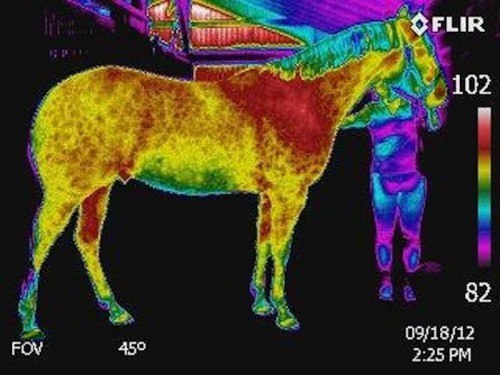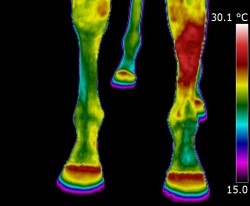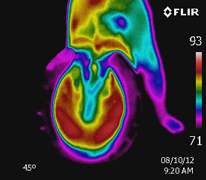Today’s guest post is brought to you by Catherine, who owns Equine Thermographics located in Raleigh, NC. Equine Thermographics specializes in taking thermographic images of horses to help diagnosis underlying issues that can’t be seen by the naked eye. I hope you’ll enjoy her article on the subject and find it as fascinating as I have! 🙂
What Can Be Found and Diagnosed?
When we think about “diagnostics” for horse care, most people think of situations where there is an existing injury, lameness, or illness that is clinically visible. Veterinarians are rarely called for other purposes, other than routine vaccinations. While this type of “reactive diagnostic” obviously plays a critical role in horse care, attention is shifting towards “preventive diagnostics.”
Preventive diagnostics refer to regular evaluations, specifically when the horse is healthy, to understand that healthy baseline and create the ability to compare data against that baseline over time. The purpose is to be able to monitor health over an extended time frame, thereby informing preventive care plans that include shoeing, joint injections, massage, chiropractic work, and acupuncture.
Until recently, performing these preventive diagnostics was cost prohibitive in that the primary option for full body diagnostic imaging has been bone scanning. This is a highly invasive technique with high risk and high cost of approximately $1500-$2500 per scan. MRI, x-ray or ultrasound is not viable because those modalities tend to focus on specific areas of the body rather than a comprehensive view.

More and more veterinarians, farriers, bodyworkers, trainers, and owners are turning to the use of thermal imaging for both preventive and reactive diagnostics. Heath that is emitted from an animal’s body can be seen with an infrared camera. Heat that is abnormal in nature can be interpreted as inflammation that would indicate either a brewing or active injury. Thermal imagery can also identify cold spots indicative of a reduction in blood supply, thrombosis, or scar tissue. One of the greatest benefits of thermal imaging is that brewing injury can be identified at the moment a metabolic change begins, meaning before an injury becomes clinically visible. This provides the opportunity to begin preventive treatment before the injury fully occurs, reducing down time. At a cost of between $250-$400 for a full body scan and veterinary interpretation, this is a fraction of other diagnostic tools, less invasive, and more comprehensive.
Specifically, what can be seen using thermal imaging? The focus is on 4 primary areas: Inflammation, Muscle Injury, Nerve Injury, and Skeletal Injury.
Thermography can be used to determine if there is inflammation in an area that is positive to palpation, or to identify areas of soreness when a horse’s behavior or performance has changed. When horses are sore or in pain, it is rarely in one area, therefore, thermography can identify all of the areas and the degree to which each area may be contributing to the horse’s issues.
A valuable use of thermal diagnostics is for muscle injury. With infrared images, we are able to locate the area of inflammation associated with a specific muscle or muscle group. While we most often see cases of increased circulation, we sometimes observe decreased circulation indicating atrophy.
Nerve damage or injury can also be identified using thermal imaging. If a nerve or nerve system suffers direct trauma or if a neurological issue impacts blood flow, these things can be identified using infrared diagnostics.
Last are skeletal issues. Infrared thermal images can illustrate areas of abnormal heat distribution in joints and skeletal structures. We can identify areas of arthritis or joint inflammation that could indicate infection, splints, bone bruises, stress fractures and bone cysts.
As with any baseline report that is done either for preventive or reactive purposes, any inflammation or lack of circulation can be monitored over time to ensure the efficacy of treatment.
To learn more about thermal imaging or to schedule an appointment for your horse, visit our website at equinethermographics.com or call us at 919-410-2826.




3 Comments
Betty Jo Arnold
September 14, 2015 at 1:24 pmThank you for posting this option. I may need to contact them!
Crossroads Vet Clinic
August 11, 2017 at 12:46 pmInteresting! Is it only applied for horses or it’s universal? I’d like to find out more about other animals
Bentleighvet
December 23, 2018 at 2:46 amThanks for sharing this post. I am very interested in this topic. I would like to share my opinion on this.It’s best to try to discover a couple of Vet Techs at your native veterinary hospital and see if you can ask them what it’s like being a tech, and if they’ve any suggestions for you. Ask them to explain their typical day.